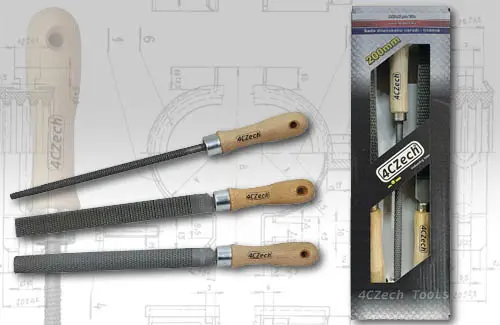The regular price is the current manufacturer's recommended price! FREE shipping for orders over EUR 41,67 within CZ+SK (PPLparcel)

Is there a difference between a file and a rasp? Unlike the previously mentioned files, wood rasps are characterized primarily by increased roughness. A rasp is usually a large hand-held carpenter's file.
Rasps are widely used in many industries where it is necessary to adjust the surface, remove irregularities or precisely shape the processed materials.
Choosing a workshop rasp depends on several factors, such as the material you will be processing, the type of surface treatment you want to achieve, and the accuracy you need.
1. choosing a rasp by shape:
• Flat rasps – a universal type, suitable for basic processing of flat surfaces.
• Round (circular) rasps – for rounded shapes or holes.
• Half-round (segmented) rasps – suitable for flat and rounded surfaces.
2. Rasp selection by roughness:
• Coarse rasps – for fast and rough material removal.
• Medium rasps – for universal use and removal of larger amounts of material.
• Fine rasps – for fine finishing work and a smooth surface.
3. Rasp selection by cut:
• Machine cut – Machine-cut rasps are characterized by a geometrically precise cut line.
• Hand cut – Hand-cut rasps work differently from machine-cut rasps. They remove material faster and leave a better working surface thanks to higher sharpness and irregular gaps between the cut teeth, which are especially appreciated by professionals.
4. Rasp selection by length:
• Shorter rasps are more suitable for fine and precise work.
• Longer rasps are used for rough processing of larger surfaces.
5. Choosing a rasp by handle:
• Rasps with an ergonomic handle are more comfortable for longer work.
• The shape of the handle and the material matter, we must hold the rasp firmly while working and it should not slip in the palm of our hand.
When choosing a workshop rasp, try to also think about the quality and brand, because quality rasps last longer and retain their sharpness better.
There are of course many more types of rasps (see below), but they all have one thing in common. It is necessary to follow safety rules when working. Wood chips are released when rasping and it is advisable to use protective equipment, especially to protect your eyes and hands.

Other types of rasps:
Modeling rasps
Modeling rasps are used for woodworking, for wood modelers and carpenters. Hand-cut modeling rasps are used for fine finishing of wood and other soft materials, such as plastics.
Horse hoof/Farrier's rasps
Farrier rasps are used to work on horse hooves. They level the surface of the hoof, gently work on the hoof walls, and file the hooves. They have a rasp on one side and a file on the other.
Needle rasps
Needle rasps are used for fine finishing of wood and other soft materials, such as plastics. They are intended for wood modelers and carpenters, but can also be used by home DIY enthusiasts.
Disc rasps
Rotary disc rasps (also called rasp discs) replace sandpaper, angle grinder discs, and even classic chisels. Unlike them, they have fast material removal. They are clamped into an angle grinder.
Rotary shank rasps
Rotary rasps are designed for working with wood and materials based on wood, plastic, or rubber. Rasps on a shank are clamped into a drill.
Other articles:
Jak vybrat vhodný pilník nejen do dílny
Posuvná měřítka
Testy vrtáků s novou geometrií
Brusný a řezný kotouč: Klíčový nástroj pro efektivní opracování materiálů